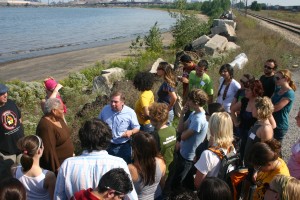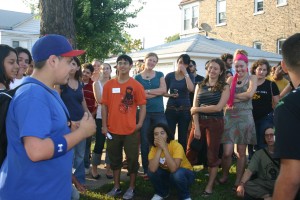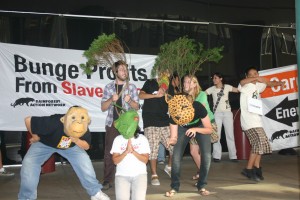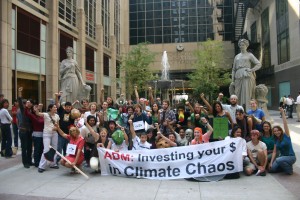Ever wanted to know what happens at RAN’s activist training camps and network gatherings? Last week we co-hosted a gathering of 60 activists in Chicago with the Student Environmental Action Coalition. Below is a reflection from Robin Markle, one of the youth leaders in RAN’s network. Robin serves on the national council of RYSE (explained below), and also helps coordinate the new Students for a Democratic Society, nationally. Below, she shares an insider’s view of the camp.
Robin Markle
Last weekend I was fortunate enough to travel to Chicago, IL for the first RAN/RYSE/SEAC Gathering. As a RAN supporter and member of the RYSE (RAN Youth Sustaining the Earth – yes that’s an acronym within an acronym!) Council, I was pretty familiar with RAN’s campaigns, but it’s rare that I get a chance to meet other RAN supporters outside of my local chapter. This gathering brought together RAN and RYSE supporters from all over North America, as well as members of SEAC, the Student Environmental Action Coalition. There was also representation from IEN, The Indigenous Environmental Network. Having so many enthusiastic activists in one place, the vast majority of them people under 25, was truly energizing and inspiring.
The gathering began Friday evening,when, after some pizza and salad, the freshly arrived participants met in a big circle to introduce ourselves and play some embarrassing ice-breaker games. The group was diverse, especially compared to other environmental gatherings I’ve been to. People came from Boston MA, Orlando FL, Oakland CA, Mexico City and Alberta, Canada. I would estimate that about half the group was female, half were people of color, and the range of identities was endless.
Saturday morning we loaded ourselves onto a schoolbus for a Toxic Tour of Whiting, IN and South Lawndale (affectionately known as “Little Village”) in Chicago. Whiting is the site of an oil refinery that is currently being expanded. Our tour was lead by two long-time community members who have been fighting the expansion. When the bus pulled up by the refinery, my first instinct was to hold my breath until we passed. The stench of oil and chemicals in the air was potent. Then I realized that a) this would not be possible since we were staying in the area for much longer than I could hold my breath, and b) this was the air some people breathed every day. Wow, privilege check.
After checking out the sights in Whiting, we moved on to Little Village. There, our second tour was lead by several youth from an organization called LVEJO (La Organizacion de Justicia Ambiental de la Villita, or, Little Village Environmental Justice Organization). LVEJO gave us an eye-opening tour that included a visiting a chemical plant and a recycling center. The youth leading the tour had been directly involved in trying to stop the chemical plant from being erected in their community. Everyone on the tour left refreshed and inspired by the work of LVEJO – to see youth standing up for their community against incredible odds was invigorating.
Sunday morning began with more stories from communities on the frontlines of environmental devastation. The first presenter was Danny from SEAC, who has been living in West Virgina and organizing around coal issues there for the last 5 years. Danny’s presentation brought tears to my eyes. We learned how the people of Appalachia are suffering severe exploitation of their land and livelihood by coal companies. Coal is a way of life there, yet it destroys the environment and hurts the health of the locals, and everyone knows it’s going to run out soon. Danny explained that though some people are resisting coal mining in their communities, a lot of the time coal companies are the only source of employment in the area. In addition, people who resist have been intimidated. People’s lives are on the line in so many ways.
Click below to read more!!
The second panel presenter was a woman named Leticia who had flown in from Paraguay. In her community, U.S. transnational corporations have bought up the rainforest land where her community lives and are planting soy and palm plantations. The companies (which include Archer Daniels Midland, Bunge and Cargill, check out the RAN Agribusiness campaign site for more info) say that they are providing jobs in Paraguay, but the plantations only employ one person per 1000 hectares, whereas the historical subsistence farming practices practiced by Leticia’s community employed 5 people per 1 hectare. So basically the land has been taken away from them so they can’t grow their own food, they can’t get jobs (or the few that are available are with the businesses that exploit them), and their entire culture, which is dependent upon their traditional farming practices and connection to the rainforest, is slowly being destroyed. And again, people who resist are having their lives threatened.
The final panelist was Eriel, a member of the Chipewya First Nation in Canada. She’d been a participant in the camp all weekend, but I didn’t know until the night before when I ran into her preparing her presentation that she is an organizer in Saskatchewan, where U.S. oil companies are drilling up her community’s land to extract oil in the dirtiest way possible, through tar sands. Eriel talked about the tar sands extraction in Fort Chipewya where she spent her summers growing up and where most of her family lives. There, oil companies have polluted the water where her family lives to the point where first they couldn’t swim in the river and then they couldn’t fish in it, and now they can’t hunt any animals that have drank water from it (i.e., all of them) because the animals are poisoned. The community already has very high rates of cancer. Because they depend on the land and animals for 80% of their needs, members of her community are now being forced into outside jobs so they can buy food and clean water from a store. And, much like in Appalachia and Paraguay, the only jobs being offered are with the oil companies, the very people responsible for all the destruction in the first place.
In addition to impact on the local communities, the tar sands extraction process is very scary – a barrel of tar sands oil produces 2.5 times as much greenhouse gases as a barrel of conventionally produced oil. The target site for tar sands extraction in Canada is roughly the size of Florida – if oil companies are allowed to extract from this entire area, the gases produced will literally put us past the tipping point for global warming, and we will never we able to repair the damage to our climate. This was some heavy information to be hearing at 10 in the morning, especially after the other two panelists.
When I saw Eriel the night before her presentation, she showed me some pictures of the tar sands and of her community on her computer. One picture she showed me I could describe with no other term than heart-breaking. It was a photo of a three-dimensional piece of art made by a member of a First Nations community impacted by the tar sands. The 28 year old artist had recreated the coast line of the water where he lives in black against a stark white background. Coming out of the coast line were two hands, black oil dripping and dribbling off of them down the page. At the bottom of the page was a line of text, “How many barrels of oil is my life worth to you?”. He made it before he died of cancer.
After hearing from all three panelists, participants divided up into three groups to learn more about the RAN campaigns targeting each issue a panelist had spoken about. The rest of the day was spent in participant-led workshops, the topics of which varied from “Resistance Music” to “Reiki” to “Building Intentional Communities”. Personally, I spent the rest of the afternoon and evening preparing for Monday’s action. After combining several ideas suggested by participants, a group of us developed a skit in which happy rainforest plants, animals and land-based people frolic in the understory, but are soon disturbed when a group of CEO’s (the famous ABC’s of Destruction – ADM, Bunge and Cargill) barge in and set up shop. The plants, animals and people are shoved into a machine and come out the other end as monocrop soy and unhappy, enslaved laborers. The skit is performed in silence while a narrator stands at the side, reciting a Dr.Suess-like poem telling the story of “The Problem with Palm Oil”.
Monday morning adrenaline was running high as we loaded back onto the schoolbus to head to our action site.The majority of those who had planned the action in detail, staying up after the talent show the night before to run through the logistics, were youth, most were high school students from Oakland CA. For many, it was there first direct action. When it came time to deploy, we literally jumped out the back of the bus, ran into position, and performed our skit for a crowd of startled traders and tourists. To the side of the skit, some participants held banners while others handed out flyers and talked to passerbys about the campaign.
In total, we probably performed the skit about a dozen times in different locations around the Board of Trade. We reached hundreds of people and actually ran out of flyers! It was one of the smoothest actions I’ve ever been a part of, thanks in part to good communication with police and the positive messaging and energy we brought. Onlookers were much more interested in learning more about a bunch of kids dressed as jungle animals than they are when protesters are chanting and carrying signs. It was a great lesson in how to build a movement that’s fun and accessible to a wide range of people. It was also a great reminder that you don’t need to be a super skilled organizer to plan and execute a really successful action – the action had been planned literally in a day, all props had been made the night before, and all of the ideas had come from high school and college students, some of whom had no previous experience doing this kind of work. With support from RAN’s staff, we had pulled together an awesome action and had a lot of fun along the way.
After an action debrief in a nearby park, we headed back to our hotel where new friends said goodbye as people slowly left in shifts for the airport. Knowing that we were all returning to very different parts of the hemisphere was sad, but also exciting: everyone brought back with them new ideas, skills and experiences that they can now share with their local community.
And so our movement grows!



